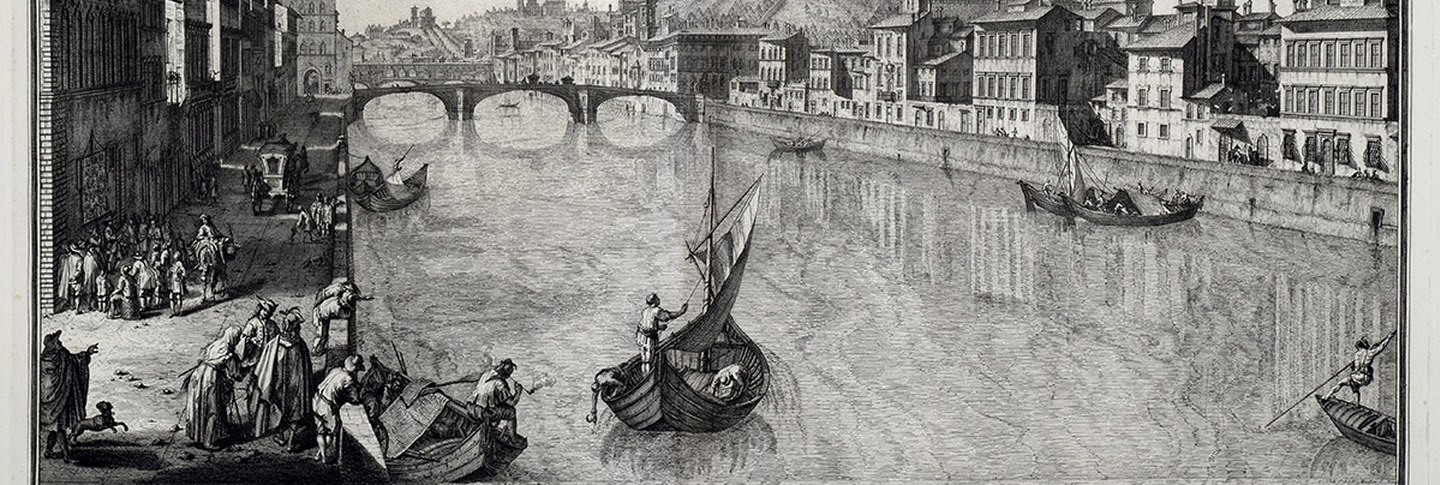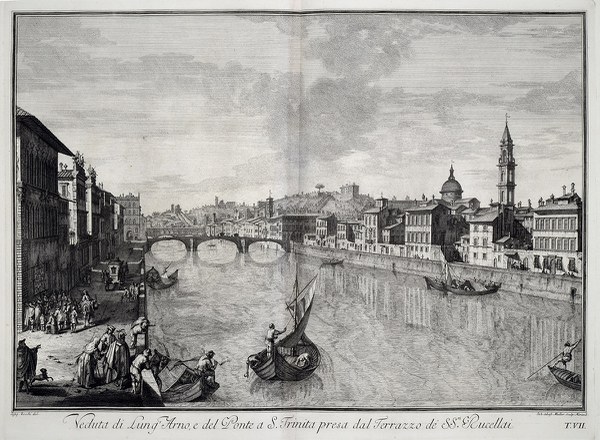There’s a peculiar vibrancy associated with water in the city. Images of strollers on Florence’s lungarni, or riverside paths, seem to encapsulate the practice of restorative leisure, while the canals of Amsterdam, photographed or painstakingly penciled in, gesture at a hybrid state between coziness and mobility. City water—channeled, controlled, incorporated—seems to posit a different way of being: life, lived harmoniously, on the edge of two elements.
City Water/City Life, which opens on April 25, will use contemporary photographs as well as prints and images from Dumbarton Oaks’ Rare Book Collection to trace the development of water elements in three historic cities—Paris, Amsterdam, and Florence—and their interaction with social and cultural milieus. The exhibit was curated by Humanities Fellow John Wang and advised by GLS Director John Beardsley and Assistant Director Anatole Tchikine.
Planning for the exhibit began back in September, as Wang, working closely with Dumbarton Oaks’ rare book librarian Linda Lott, set about acquainting himself with the Rare Book Collection: “The first step was just figuring out what was there, what you might consider for an exhibition, what types of themes might naturally emerge.” Eventually, a watery motif began to evolve: “We had these wonderful pictures of Amsterdam, Florence, Paris, all of which were capital cities at one point, and all of which had, and still have, prominent water elements—so that became its own way of looking at urban landscape.”
“Today we tend to think of water as an ecological problem—we might be concerned about rising sea levels, for instance—but in these three cases waterfront developments are deeply tied in with social and economic developments,” Wang explains. “One goal of the exhibit is to highlight how urban waters can change and influence, in multifaceted ways, the planning of a city.”
Paris, represented in the exhibit by two separate volumes, is an excellent case study in the influence of urban waters on city design. The first volume in the exhibit, featuring works by the printmaker Gabriel Perelle and his sons, Adam and Nicolas, dates from the mid-seventeenth century; the second, by Jacques Rigaud, is from the eighteenth century. “You end up with this really nice one-century comparison,” Wang explains. “In the earlier volume, the river is crowded with barges and these signs of commercial activity, whereas in the second volume, the river becomes cleaner, more picturesque—a shift begins to emerge, from Paris as a commercial center to a cultural center.”
Images featured in the exhibit range from the idyllic to the technical. Giuseppe Zocchi’s engravings of eighteenth-century Florence, for instance, depict a period when the Arno began to take on a more prominent role in civic life. “There are a lot of scenes of promenading along the river, aristocrats in their carriages, and so on,” Wang says. “They’re beautiful prints in their own right, but they’re also executed in this strict documentary style—they’re artistic and historical at the same time.” In contrast, one of the volumes focusing on Amsterdam—a compendium of prints by different engravers—examines the construction of the city’s famous dikes and the process of land reclamation from the angle of hydraulic engineering.
In examining the uses of water through time, the exhibit leaps forward three centuries by incorporating contemporary photographs. Sometimes, the interactions of water and culture have led to devastation. A picture of Florence, for instance, captures the destruction wrought by the 1966 flooding of the Arno, which irreparably damaged millions of artworks and rare books.
At other times, water carries its culture backward, returning to old solutions. Along the canals of Amsterdam, history curiously recurs: “For Amsterdam, we have an image of contemporary houseboats, and there’s a whole story behind that,” Wang explains. “In the postwar period, during a housing shortage, barges started to be converted into dwellings, as a sort of emergency solution. Now, that same process is looked on as an innovative solution to the problem the city still has of housing its growing population.”
The combination of historical and contemporary perspectives is aimed at bolstering analysis of this notoriously mutable element. In line with this objective, the exhibit has been designed in conjunction with two upcoming events. The D.C. Water Atlas, an online map of the D.C. watershed created by Dumbarton Oaks Tyler Fellow John Davis, is expected to launch this summer, while the 2017 Garden and Landscape Studies Symposium, “Landscape of Pre-Industrial Cities,” which will take place May 5–6, reflects on many of the same themes.
Between the exhibit, project, and symposium, the subject of city water—no less protean than beautiful—will certainly get its due.
Image: An engraving of activity on the Arno by Giuseppe Zocchi, from a volume in the Rare Book Room.

